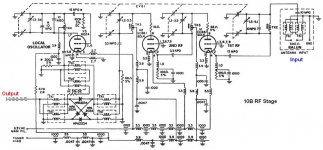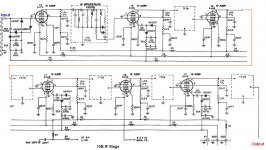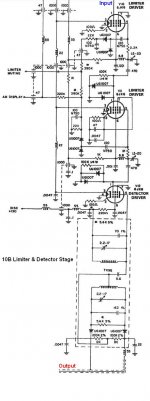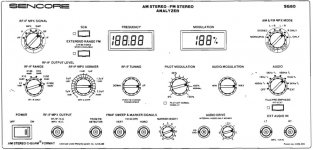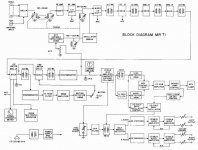I picked up a FM tuner scope/crt tube brand new about 20 years ago. I still have it..... the thought was that one day I would have a 10B or Sequerra and I'd surely need a crt later and they wouldnt be available. I just saw that tube yesterday when plowing thru boxes of stuff. I also have a Sencor SG80 gathering dust... waiting for that FM tuner to align it back to new. But, I dont think I'll ever have one of those tuners. sigh.
-Richard Marsh
-Richard Marsh
Last edited:
The CRT is only an expensive way to build a multi indicator (*). The technical beauty and real value of the 10B tuner is in the (complex) tuner circuitry and (surprise!) in the attention to mundane points.
Please notice the meticulous B+ and heater lines decoupling where it matters.
George
(*)
RF: Signal strength, tune centering and multipath interference indicator.
AF: Phase scope
Please notice the meticulous B+ and heater lines decoupling where it matters.
George
(*)
RF: Signal strength, tune centering and multipath interference indicator.
AF: Phase scope
Attachments
John, don't misunderstand me. I keep a great respect for your work.Thank you for your candid warning,
May-be it has a stronger value, because it comes from a professional (Only 5 years younger than you), than all those hype awards, while it will not increase any sales ;-)
I'm sad you have to worry for your living after all those years of work. In an another way, it can be a luck you can continue to exercise your passion ?
Scott, too bad that you cannot hear the difference.
Glad to be there to observe anyone who can.
Unspecified is the difference between what and what. Gratuitous insults really should be better focused and composed else they lose their effect.
OK SY you old erfulblerm, you are snerkle, grazzed and firfledump!
And a year older!
Last edited:
Unspecified is the difference between what and what. Gratuitous insults really should be better focused and composed else they lose their effect.
This message is brought to you, of course, by means of unfocused and ill composed gratuitous insult.
OK SY you old erfulblerm, your are snerkle, grazzed and firfledump!
My wife agrees. She also added that I was a frizzlepated exnorite. And a few other words not allowed on the forum.
Sounds to me like a women of insight and good judgment . You may quote me on that.My wife agrees. She also added that I was a frizzlepated exnorite. And a few other words not allowed on the forum.

What would be so different in the 10B tuner than say the tube McIntosh MR71 tuner that I have or the later SS model mentioned earlier and the old SAE II tuner that I sill have sitting on a shelf? Both of these tuners have been some of the best I have heard that actually can discriminate between adjacent stations and lock on a signal. What makes the 10B such a unique tuner vs many others such as my Mac or say some of the older Fisher tuners of old?
The Mac tuner that you have is supposed to be darn good too, but perhaps for different reasons. The Fisher tube tuners are good, but not as good as the Mac or the Marantz 10.
My Marantz tuner is a 10, rather than a 10B. It DOES have some tubes in it that are difficult to get. The oscilloscope feature is nice, but not necessary, except for people who can control their antennas.
My Marantz tuner is a 10, rather than a 10B. It DOES have some tubes in it that are difficult to get. The oscilloscope feature is nice, but not necessary, except for people who can control their antennas.
What would be so different
If 10B and MR71 are well maintained, there will be not much difference btn these two. But the 10B has three optocouplers which fade with time and degrade the performance of the tuner.
In general, there can be no simple answer to the question ‘which tuner should I choose’ (and IMO tuners are much more complex and demanding compared to RIAA preamps)
The most important of all the criteria is what are the reception conditions and requirements at your location.
If you live in a remote area with a few FM radio stations far away from you which are not close enough in frequency, you will mainly need a simple tuner with good front section sensitivity and low noise plus a good rotating directional antenna. If you live in a metropolitan area with too many FM strong and week stations closely spaced, the requirements are tough and you will have to worry about front stage overloading and selectivity, LO pulling, IF selective bandwidth, much of image and AM rejection ect, that is, there is a need for a complex and well engineered tuner.
Block diagrams and detailed circuit diagrams will tell a lot. Then construction details, then specs. A good site for tuners info is Tuner Information Center - Vintage Stereo Tuners
George
Attachments
Last edited:
If 10B and MR71 are well maintained, there will be not much difference btn these two.
I find the $79 Kaito SW/AM/FM quite adequate and a JC predicted I could not tell the difference between it and an expensive 70's vintage tuner.
Kaito KA1103 Product Reviews
Let's get back to phono stages. What makes them exceptional?
This is actually an interesting area of electronics design that people often don't get right. Noise, noise rejection, RIAA conformance, headroom, overload recovery, correct input impedance, microphonics, output impedance/drive capability. Linearity is nice, but that's actually fairly easy at these low signal swings. There are quite a few superb phono stages, but quite a few more that... aren't.
- Status
- Not open for further replies.
- Home
- Member Areas
- The Lounge
- John Curl's Blowtorch preamplifier part II
